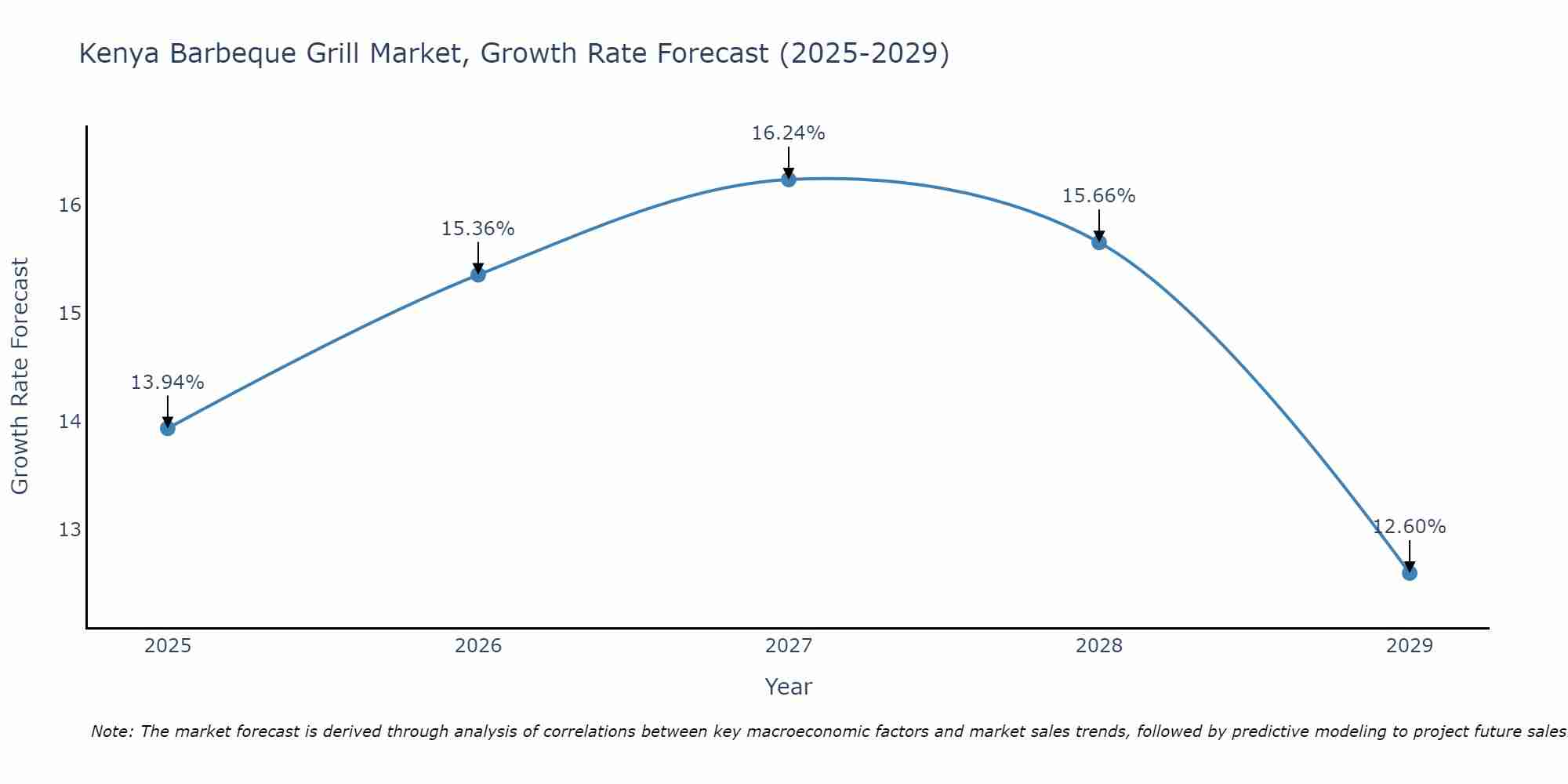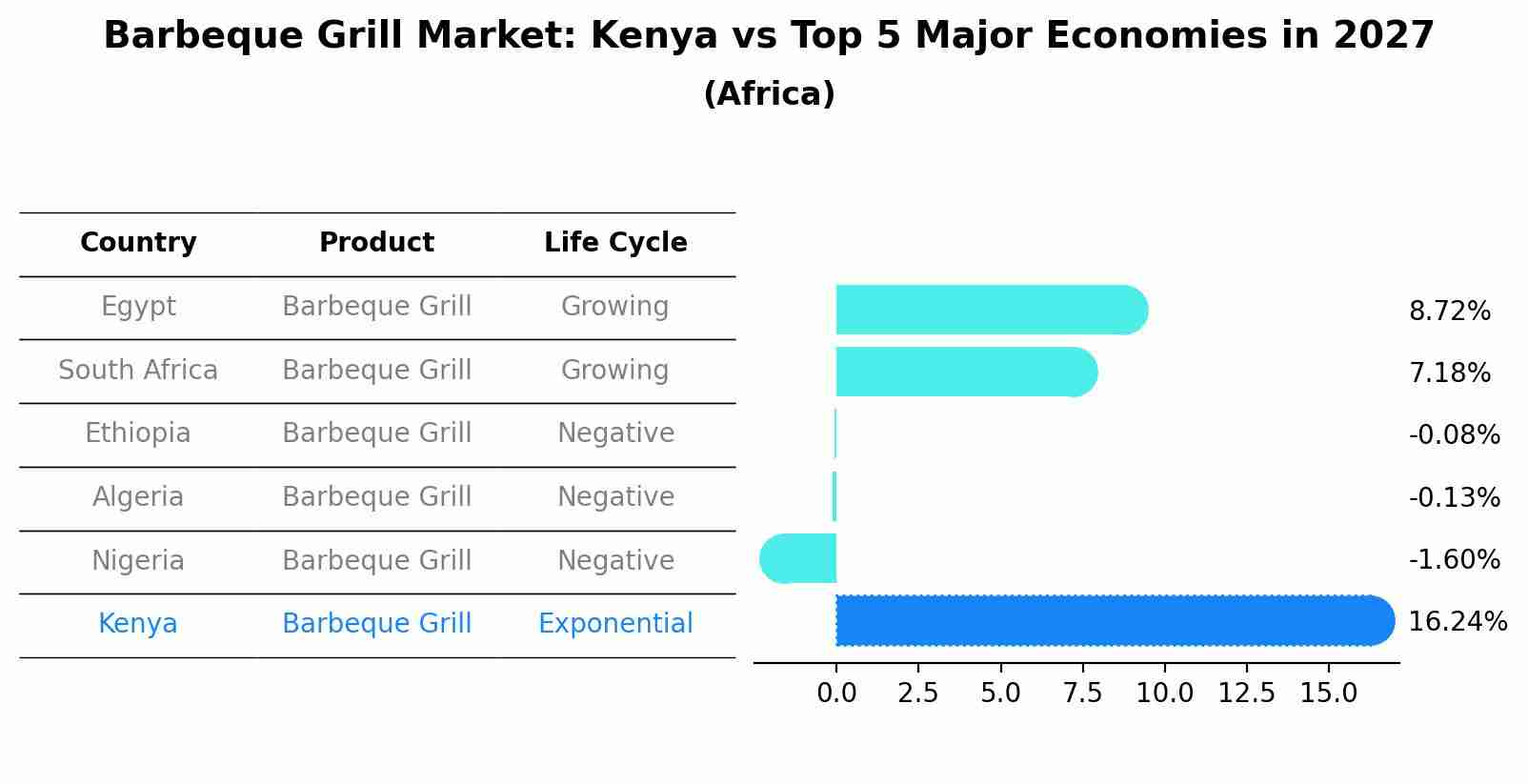Kenya Barbeque Grill Market Outlook | Value, Growth, Industry, Forecast, COVID-19 IMPACT, Revenue, Companies, Size, Analysis, Share & Trends
| Product Code: ETC130541 | Publication Date: Jun 2021 | Updated Date: Jun 2025 | Product Type: Report | |
| Publisher: 6Wresearch | Author: Dhaval Chaurasia | No. of Pages: 70 | No. of Figures: 35 | No. of Tables: 5 |
Kenya Barbeque Grill Market Size Growth Rate
The Kenya Barbeque Grill Market is projected to witness mixed growth rate patterns during 2025 to 2029. The growth rate begins at 13.94% in 2025, climbs to a high of 16.24% in 2027, and moderates to 12.60% by 2029.

Barbeque Grill Market: Kenya vs Top 5 Major Economies in 2027 (Africa)
By 2027, Kenya's Barbeque Grill market is forecasted to achieve a exponential growth rate of 16.24%, with Egypt leading the Africa region, followed by South Africa, Ethiopia, Algeria and Nigeria.

Kenya Barbeque Grill Market Overview
The Kenya Barbeque Grill Market is experiencing steady growth driven by the rising popularity of outdoor cooking and social gatherings. In urban areas, the market is primarily fueled by the trend of apartment living with limited space for traditional grilling, leading to a surge in demand for compact and portable grills. Additionally, the growing disposable income among the middle-class population has increased the willingness to invest in higher-quality grills and accessories. Key players in the market offer a wide range of products catering to various consumer preferences, including gas, charcoal, and electric grills. The market is also witnessing a shift towards eco-friendly and energy-efficient grilling options, reflecting the overall sustainability trend in consumer goods. Overall, the Kenya Barbeque Grill Market presents opportunities for innovation and product diversification to meet the evolving consumer needs.
Kenya Barbeque Grill Market Trends
The Kenya Barbeque Grill Market is experiencing a growing demand for portable and compact grills, catering to the increased popularity of outdoor cooking and social gatherings. Consumers are looking for convenient and easy-to-use options that can be easily transported for picnics, camping, and other outdoor activities. Additionally, there is a rising interest in innovative features such as temperature control, smokeless technology, and energy efficiency. Health and environmental consciousness are also influencing purchasing decisions, with a preference for grills that promote healthier cooking methods and sustainable practices. Overall, the market is witnessing a shift towards more versatile, user-friendly, and environmentally friendly barbeque grill options to meet the evolving preferences and lifestyles of consumers in Kenya.
Kenya Barbeque Grill Market Challenges
In the Kenya Barbeque Grill market, several challenges are faced by both manufacturers and retailers. One major challenge is the high importation costs of quality grills, which can drive up prices and hinder market growth. Additionally, fluctuations in exchange rates and import regulations can impact the availability and affordability of barbeque grills in the market. Limited consumer awareness and preferences for traditional cooking methods also pose a challenge in expanding the market for barbeque grills. Furthermore, competition from alternative cooking appliances and the seasonal nature of barbequing in Kenya can present obstacles for consistent demand and sales. Overcoming these challenges will require innovative marketing strategies, partnerships with local suppliers, and efforts to educate consumers on the benefits of barbeque grills.
Kenya Barbeque Grill Market Investment Opportunities
In the Kenya barbecue grill market, there are various investment opportunities for both local and international investors. With the growing popularity of outdoor cooking and dining experiences, there is a demand for high-quality and innovative barbecue grills. Investing in the manufacturing or distribution of modern and efficient grills tailored to the Kenyan market preferences could be lucrative. Additionally, there is an opportunity to provide accessories, such as utensils, marinades, and recipe books, to complement the grilling experience. Furthermore, investing in barbecue events, competitions, and festivals can also be a profitable venture as they continue to gain traction in Kenya. Overall, capitalizing on the rising interest in barbecue culture presents promising investment opportunities in the Kenyan market.
Kenya Barbeque Grill Market Government Policy
The Kenyan government has various policies that impact the barbecue grill market. These include regulations on food safety and hygiene standards to ensure the quality of grilled food. Additionally, import taxes and tariffs on barbecue grills may affect pricing and availability in the market. The government also plays a role in promoting local manufacturing of grills through incentives and support programs. Environmental regulations regarding waste disposal and emissions from grilling activities are also relevant for businesses in the market. Overall, government policies in Kenya aim to balance consumer safety, industry growth, and environmental sustainability in the barbecue grill market.
Kenya Barbeque Grill Market Future Outlook
The Kenya Barbeque Grill market is poised for steady growth in the coming years due to increasing consumer interest in outdoor cooking and dining experiences. Factors such as rising disposable incomes, changing food preferences towards grilled and smoked dishes, and a growing culture of social gatherings and entertainment at home are driving the demand for barbeque grills in Kenya. Additionally, the influence of global culinary trends and the popularity of outdoor leisure activities are expected to further fuel market growth. Manufacturers are likely to focus on product innovation, introducing advanced features such as smart technology integration and sustainable materials to cater to evolving consumer preferences. Overall, the Kenya Barbeque Grill market is anticipated to expand, offering opportunities for both local and international players to capitalize on the growing demand.
Key Highlights of the Report:
- Kenya Barbeque Grill Market Outlook
- Market Size of Kenya Barbeque Grill Market, 2021
- Forecast of Kenya Barbeque Grill Market, 2027
- Historical Data and Forecast of Kenya Barbeque Grill Revenues & Volume for the Period 2018 - 2027
- Kenya Barbeque Grill Market Trend Evolution
- Kenya Barbeque Grill Market Drivers and Challenges
- Kenya Barbeque Grill Price Trends
- Kenya Barbeque Grill Porter's Five Forces
- Kenya Barbeque Grill Industry Life Cycle
- Historical Data and Forecast of Kenya Barbeque Grill Market Revenues & Volume By Product for the Period 2018 - 2027
- Historical Data and Forecast of Kenya Barbeque Grill Market Revenues & Volume By Gas for the Period 2018 - 2027
- Historical Data and Forecast of Kenya Barbeque Grill Market Revenues & Volume By Charcoal for the Period 2018 - 2027
- Historical Data and Forecast of Kenya Barbeque Grill Market Revenues & Volume By Electric for the Period 2018 - 2027
- Historical Data and Forecast of Kenya Barbeque Grill Market Revenues & Volume By Application for the Period 2018 - 2027
- Historical Data and Forecast of Kenya Barbeque Grill Market Revenues & Volume By Household for the Period 2018 - 2027
- Historical Data and Forecast of Kenya Barbeque Grill Market Revenues & Volume By Commercial for the Period 2018 - 2027
- Kenya Barbeque Grill Import Export Trade Statistics
- Market Opportunity Assessment By Product
- Market Opportunity Assessment By Application
- Kenya Barbeque Grill Top Companies Market Share
- Kenya Barbeque Grill Competitive Benchmarking By Technical and Operational Parameters
- Kenya Barbeque Grill Company Profiles
- Kenya Barbeque Grill Key Strategic Recommendations
Frequently Asked Questions About the Market Study (FAQs):
Kenya Barbeque Grill |
1 Executive Summary |
2 Introduction |
2.1 Key Highlights of the Report |
2.2 Report Description |
2.3 Market Scope & Segmentation |
2.4 Research Methodology |
2.5 Assumptions |
3 Kenya Barbeque Grill Market Overview |
3.1 Kenya Country Macro Economic Indicators |
3.2 Kenya Barbeque Grill Market Revenues & Volume, 2021 & 2027F |
3.3 Kenya Barbeque Grill Market - Industry Life Cycle |
3.4 Kenya Barbeque Grill Market - Porter's Five Forces |
3.5 Kenya Barbeque Grill Market Revenues & Volume Share, By Product, 2021 & 2027F |
3.6 Kenya Barbeque Grill Market Revenues & Volume Share, By Application, 2021 & 2027F |
4 Kenya Barbeque Grill Market Dynamics |
4.1 Impact Analysis |
4.2 Market Drivers |
4.3 Market Restraints |
5 Kenya Barbeque Grill Market Trends |
6 Kenya Barbeque Grill Market, By Types |
6.1 Kenya Barbeque Grill Market, By Product |
6.1.1 Overview and Analysis |
6.1.2 Kenya Barbeque Grill Market Revenues & Volume, By Product, 2018 - 2027F |
6.1.3 Kenya Barbeque Grill Market Revenues & Volume, By Gas, 2018 - 2027F |
6.1.4 Kenya Barbeque Grill Market Revenues & Volume, By Charcoal, 2018 - 2027F |
6.1.5 Kenya Barbeque Grill Market Revenues & Volume, By Electric, 2018 - 2027F |
6.2 Kenya Barbeque Grill Market, By Application |
6.2.1 Overview and Analysis |
6.2.2 Kenya Barbeque Grill Market Revenues & Volume, By Household, 2018 - 2027F |
6.2.3 Kenya Barbeque Grill Market Revenues & Volume, By Commercial, 2018 - 2027F |
7 Kenya Barbeque Grill Market Import-Export Trade Statistics |
7.1 Kenya Barbeque Grill Market Export to Major Countries |
7.2 Kenya Barbeque Grill Market Imports from Major Countries |
8 Kenya Barbeque Grill Market Key Performance Indicators |
9 Kenya Barbeque Grill Market - Opportunity Assessment |
9.1 Kenya Barbeque Grill Market Opportunity Assessment, By Product, 2021 & 2027F |
9.2 Kenya Barbeque Grill Market Opportunity Assessment, By Application, 2021 & 2027F |
10 Kenya Barbeque Grill Market - Competitive Landscape |
10.1 Kenya Barbeque Grill Market Revenue Share, By Companies, 2021 |
10.2 Kenya Barbeque Grill Market Competitive Benchmarking, By Operating and Technical Parameters |
11 Company Profiles |
12 Recommendations |
13 Disclaimer |
- Single User License$ 1,995
- Department License$ 2,400
- Site License$ 3,120
- Global License$ 3,795
Search
Thought Leadership and Analyst Meet
Our Clients
Related Reports
- Canada Oil and Gas Market (2026-2032) | Share, Segmentation, Value, Industry, Trends, Forecast, Analysis, Size & Revenue, Growth, Competitive Landscape, Outlook, Companies
- Germany Breakfast Food Market (2026-2032) | Industry, Share, Growth, Size, Companies, Value, Analysis, Revenue, Trends, Forecast & Outlook
- Australia Briquette Market (2025-2031) | Growth, Size, Revenue, Forecast, Analysis, Trends, Value, Share, Industry & Companies
- Vietnam System Integrator Market (2025-2031) | Size, Companies, Analysis, Industry, Value, Forecast, Growth, Trends, Revenue & Share
- ASEAN and Thailand Brain Health Supplements Market (2025-2031) | Strategy, Consumer Insights, Analysis, Investment Trends, Opportunities, Growth, Size, Share, Industry, Revenue, Segments, Value, Segmentation, Supply, Forecast, Restraints, Outlook, Competition, Drivers, Trends, Demand, Pricing Analysis, Competitive, Strategic Insights, Companies, Challenges
- ASEAN Bearings Market (2025-2031) | Strategy, Consumer Insights, Analysis, Investment Trends, Opportunities, Growth, Size, Share, Industry, Revenue, Segments, Value, Segmentation, Supply, Forecast, Restraints, Outlook, Competition, Drivers, Trends, Demand, Pricing Analysis, Competitive, Strategic Insights, Companies, Challenges
- Europe Flooring Market (2025-2031) | Outlook, Share, Industry, Trends, Forecast, Companies, Revenue, Size, Analysis, Growth & Value
- Saudi Arabia Manlift Market (2025-2031) | Outlook, Size, Growth, Trends, Companies, Industry, Revenue, Value, Share, Forecast & Analysis
- Uganda Excavator, Crane, and Wheel Loaders Market (2025-2031) | Strategy, Consumer Insights, Analysis, Investment Trends, Opportunities, Growth, Size, Share, Industry, Revenue, Segments, Value, Segmentation, Supply, Forecast, Restraints, Outlook, Competition, Drivers, Trends, Demand, Pricing Analysis, Competitive, Strategic Insights, Companies, Challenges
- Rwanda Excavator, Crane, and Wheel Loaders Market (2025-2031) | Strategy, Consumer Insights, Analysis, Investment Trends, Opportunities, Growth, Size, Share, Industry, Revenue, Segments, Value, Segmentation, Supply, Forecast, Restraints, Outlook, Competition, Drivers, Trends, Demand, Pricing Analysis, Competitive, Strategic Insights, Companies, Challenges
Industry Events and Analyst Meet
Whitepaper
- Middle East & Africa Commercial Security Market Click here to view more.
- Middle East & Africa Fire Safety Systems & Equipment Market Click here to view more.
- GCC Drone Market Click here to view more.
- Middle East Lighting Fixture Market Click here to view more.
- GCC Physical & Perimeter Security Market Click here to view more.
6WResearch In News
- Doha a strategic location for EV manufacturing hub: IPA Qatar
- Demand for luxury TVs surging in the GCC, says Samsung
- Empowering Growth: The Thriving Journey of Bangladesh’s Cable Industry
- Demand for luxury TVs surging in the GCC, says Samsung
- Video call with a traditional healer? Once unthinkable, it’s now common in South Africa
- Intelligent Buildings To Smooth GCC’s Path To Net Zero


















